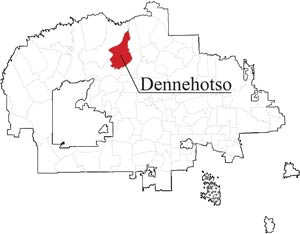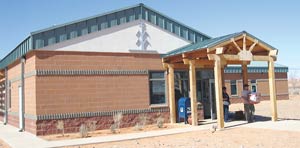Getting back to green
Dennehotso wants to be the world's best farm town
By CIndy Yurth
Tséyi' Bureau
DENNEHOTSO, Ariz., March 7, 2013
(Editor's note: In an effort to chronicle the beauty and diversity of the Navajo Nation, as well as its issues, the Navajo Times has committed to visiting all 110 chapters in alphabetical order. This is the 25th in the series.)


F or their chapter's emblem on the beautiful new $4 million multi-purpose building, the leaders of Dennehotso chose a stalk of corn.
It looks almost laughable against the rock spires and red "blow-sand" of the chapter, but make no mistake: The cornfields of Dennehotso were once the envy of the land.
Quite literally. In the distant past, said Chapter President Frank Yazzie, the Utes were so jealous of the Navajos' spectacular harvest they raided the rocky knob where the Diné had threshed their crops, torching the piles of produce and inadvertently giving the place the name it still bears today: Burnt Corn Hill.
When Yazzie was a boy, "We used to play hide-and-seek in the cornfields," he said. "The corn was so high you couldn't even find each other."
In the 1940s, Dennehotso started harvesting a different crop. Vanadium Corporation of America opened a large uranium mine on the far side of Comb Ridge, and virtually the whole town relocated to work the mine.
Living and working at the heavily radioactive site took its toll as the miners and some of their spouses started to come down with cancer.
"Within 20 years," said Yazzie, "the uranium took an entire generation from us." To this day, he said, it's hard to find a Dennehotsoan between 70 and 80 years of age.
That was also the beginning of the end of the farming era. The age-old cycle was broken; people started looking for cash jobs in the nearby cities of Cortez, Colo. and Farmington, N.M. Gradually the beautiful farms on the shores of the Laguna Wash were left fallow.
Best in the world
So why would Dennehotso put a cornstalk on its two-year-old multi-purpose building? Out of nostalgia for the past?
Not at all, said Yazzie and Chapter Land Use Planning Committee Chairman Asa Begaye. More like a reminder of their goal for the future.
"We want to be the best farming community in the world," Begaye said without batting an eye.
The world? Doesn't he mean, maybe, the Navajo Nation? Or northern Arizona?
Nope. You heard him right.
Begaye and Yazzie are both disciples of self-help guru Jack Canfield, who says in his books most people don't get what they want because they don't set their goals high enough or state them clearly enough.
It doesn't get much higher or clearer than wanting to be the best farming community in the world. But, um, what does the rest of the world think of this?
Believe it or not, nobody's laughing.
"Ever since we came up with that goal," Yazzie said, "the help has been pouring in."
The Navajo Agricultural Products Industry planted 38 acres of winter wheat as a demonstration project.
The U.S. Department of Agriculture came and sampled the soil (diagnosis: "We can grow anything we want," said Begaye).
The local LDS Church has provided free seeds and drip irrigation tubing to its members.
"You should see the things people are growing in their little gardens," said Yazzie.
Suddenly, everybody is rooting for little Dennehotso.
"We're on a roll," Begaye said.
Other baskets
But the town — and you might as well start calling it a town; Begaye and Yazzie are hoping that it can somehow turn into enough of a town to collect some of Arizona's transaction privilege tax set aside for municipalities — has not put all its eggs in the agricultural basket. Yazzie is proud of the fact that his chapter has spent the most money of any chapter in the last 10 years: $20 million.
Much of that went to power lines — "We're 100 percent electrified," boasted Chapter Manager Carmelia Blackwater. There's also big IHS water project in the works, and the chapter has undertaken a massive strategic planning initiative.
One-hundred-fifty acres has been withdrawn along U.S. 160 for the Desert Meadows Development Area, soon to include a convenience store and a veterans' park.
When young people who had moved away were quizzed on what would bring them back, the answer was nearly unanimous: the Internet. Dennehotso invested in Wild Blue satellite Internet for anyone who wants to use it. And, true to their word, the young people have started moving back.
Although some may stifle a snicker (probably the same folks who would roll their eyes at the "Best farm town in the world" thing), Dennehotso has also made a strategic plan using the Smart Growth system popular in much more urban areas — planning around "walkable communities" of homes, schools and businesses.
"We have to start somewhere," Begaye said, "and we have lots of people who like to walk, including me."
Dennehotso also has the distinction of sprawling across parts of two states and three counties — San Juan County, Utah; Apache County, Ariz. and Navajo County, Ariz.
While this presents some jurisdictional issues, the ever-positive Yazzie and Begaye prefer to think of it as an opportunity.
"We have plenty of potential partners for projects," said Begaye. "Sometimes Navajos forget we are part of a state and a county." Or multiple ones, in Dennehotso's case.
Involved community
Blackwater said the community is excited about the new direction it's taking.
"They're getting really involved," she said. "We have a lot of meetings. They take it upon themselves to find out what's going on."
Once the farm and convenience store are in, Begaye and Yazzie want to start focusing on capturing some of the tourists that zip by Dennehotso on their way to Monument Valley to the west or Bluff, Utah to the east.
Begaye envisions a secluded resort on the rim of Comb Ridge. The area has some breathtaking dinosaur tracks.
Then there are the tiny burgundy-colored garnets that glitter in the sand of Garnet Ridge.
"You know how some of those places in Alaska let people pan gold for a price?" he asked. "Well, we could let people look for garnets."
Even the pesky blow-sand may turn out to be a product.
"We're talking about making sandbags," Yazzie said.
It's too bad Yazzie and Begaye can't package their optimism and export it. That may be their chapter's biggest asset of all.
Dennehotso at a glance
Name — A corruption of Deinihootso, "Meadows Merging," a reference to the beautiful green fields that once characterized the area
Land area — 291,957 acres, outlined in what Chapter Land Use Planning Committee Chairman Asa Begaye likes to call "the shape of a dancing bear"
Population — 746 in the 2010 census, although Chapter President Frank Yazzie estimates it's twice to three times that figure
Famous sons and daughters — Katherine Benally, the only female delegate in the Navajo Nation Council; Fred Begay, the first Navajo scientist; Navajo Nation Supreme Court Chief Justice Herb Yazzie and Navajo Nation Attorney General Harrison Tsosie
History — Remains of early Navajo camps can be found along the base of Comb Ridge, and oral history says the people retreated to the shelter of the rocky ridge in the winter, migrating to the Laguna Wash in the summer to grow their crops. After the Long Walk, Dennehotso was part of the original reservation set up by the Treaty of 1868. Twin girls who had been born at Hweeldi came to Dennehotso with their family and, after they married, became known as "The Water Master's Wife" and "Crooked Neck's Wife." Most of the present-day Dennehotso families can trace their lineage to one of the twins, who both lived to be over 100.
Ambition — To be the best farming community in the world
Assets — High water table, fertile soil, Baby Rocks, dinosaur tracks, garnets, U.S. 160, 100 percent electrified community
Problems — U.S. 160 (in terms of potential accidents and chemical spills), much desireable land taken up by rights-of-way for electric and gas lines, no businesses

